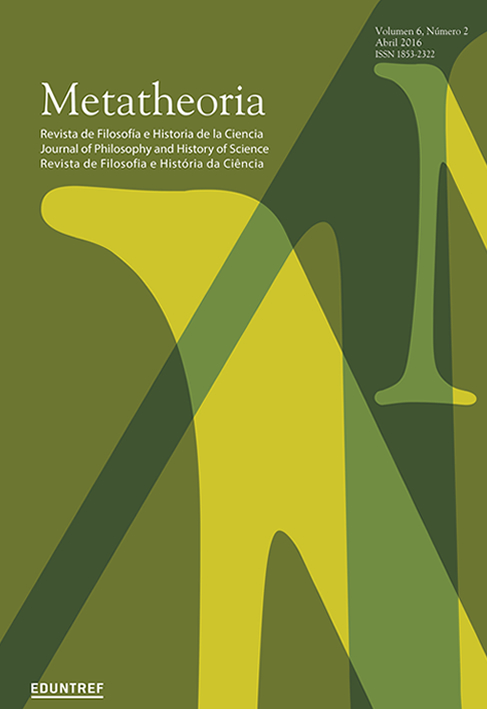The Evolutionary Developmental Biology and the Emergence of a New Theory of Evolution
DOI:
https://doi.org/10.48160/18532330me6.251Keywords:
evo-devo, ideal of natural order, explanatory targets, theory of natural selection, ToulminAbstract
The results of Evolutionary Developmental Biology presuppose a second theory of evolution. A theory that, being complementary, and not contrary or alternative, to the Theory of Natural Selection, cannot be considered its mere subaltern or its auxiliary. That theory, however, is not easily individualized. It is disseminated, and tacitly assumed, in the conceptual developments and in the empirical results of Evo-Devo. But if one identifies what Stephen Toulmin would characterize as the ideal of natural order to which these developments and results respond, the outlines and nature of that theory begin to become a little sharper.
References
Agustí J. (2003), Fósiles, genes y teorías, Barcelona: Tusquets.
Alberch, P. (1989), “The Logic of Monsters: Evidence for Internal Constraint in Development and Evolution”, Geobios(mémoire spécial)12: 21-57.
Alberch, P. (1980), “Ontogenesis and Morphological Diversification”, American Zoologist20: 653-667.
Amundson, R. (1998), “Two Concepts of Constraint: Adaptationism and the Challenge from Developmental Biology”, en Hull, D. y M. Ruse (eds.), The Philosophy of Biology, Oxford: Oxford University Press, pp. 93-116.
Amundson, R. (2001), “Adaptation and Development: On the Lack of a Common Ground”, en Orzack, S. y E. Sober (eds.), Adaptationism and Optimality, Cambridge: Cambridge University Press, pp. 303-334.
Amundson, R. (2005), The Changing Role of the Embryo in Evolutionary Thought, Cambridge: Cambridge University Press.
Arthur, W. (1997), The Origin of Animal Body Plans, Cambridge: Cambridge University Press.
Arthur, W. (2000), “The Concept of Developmental Reprogramming and the Quest for an Inclusive Theory of Evolutionary Mechanisms”, Evolution & Development2: 49-57.
Arthur,W. (2001), “Developmental Drive: An Important Determinant of the Direction of Phenotypic Evolution”, Evolution & Development3: 271-278. Arthur, W. (2004a), Biased Embryos and Evolution, Cambridge: Cambridge University Press.
Arthur, W. (2004b), “The Effect of Development on the Direction of Evolution: Toward a Twenty-Century Consensus”, Evolution & Development6: 282-288.
Azkonobieta, T. (2005), Evolución, desarrollo y (auto)organización. Un estudio sobre los principios filosóficos de la Evo-Devo, Tesis doctoral, San Sebastián: Universidad del País Vasco.
Caponi, G. (2004), “La navaja de Darwin”, Ludus Vitalis12: 9-38.
Cuvier, G. (1805), Leçons d’anatomie comparée, Paris: Badouin.
Darwin, C. (1859), On the Origin of Species, London: Murray.
Dawkins, R. (1996), Climbing Mount Improbable, London: Penguin.
Dennett, D. (1995), Darwin’s Dangerous Idea, London: Penguin.
Dennett, D. (2000), “With a Little Help from my Friends”, en Ross, D., Brook, A. y D. Thompson (eds.), Dennett’s Philosophy, Cambridge: MIT Press, pp. 327-388.
Eldredge, N. y J. Cracraft (1980), Phylogenetic Patterns and the Evolutionary Process, New York: Columbia University Press.
Fernandez, F., Galliez, M. y M. Leite (2007), “O gambá que inventou o submarino”, Ciência Hoje39: 70-72.
Goodwin, B. (1998), Las manchas del leopardo, Tusquets: Barcelona.
Gould, S. (1991), “The Disparity of the Burguess Shale Arthropod Fauna and the Limits to Cladistic Analysis: Why we Must strive to Quantify Morphospace”, Paleobiology17: 411-423.
Gould, S. (2002), The Structure of Evolutionary Theory, Cambridge: Harvard University Press.
Hall, B. (1992), Evolutionary Developmental Biology, London: Chapman & Hall.
Hennig, W. (1968), Elementos de una sistemática filogenética, Buenos Aires: EUDEBA.
Laubichler, M. (2007), “Evolutionary Developmental Biology”, en Hull, D. y M. Ruse (eds.), The Cambridge Companion to Philosophy of Biology, Cambridge: Cambridge University Press, pp. 342-360.
Maynard Smith, J., Burian, R., Kauffman, S., Alberch, P., Campbell, B., Goodwin, B., Lande, R., Raup, D. y L. Wolpert (1985), “Developmental Constraints and Evolution”, The Quarterly Review of Biology60: 265-287.
Newton, I. ([1726]1962), Mathematical Principles of Natural Philosophy, Berkeley: University of California Press.
Raff, R. (2000), “Evo-Devo: The Evolution of a New Discipline”, Nature Reviews Genetics1: 74-79.
Raff, R. (1996), The Shape of Life: Genes, Development and the Evolution of Animal Form, Chicago: The University of Chicago Press.
Schwnenk, K. y G. Wagner (2003), “Constraint”, en Hall, B. y W. Olson (eds.), Keywords and Concepts in Evolutionary Developmental Biology, Cambridge: Harvard University Press, pp.52-60.
Schmitt, S. (2006), Aux origines de la biologie moderne, Paris: Belin.
Sober, E. (1984), The Nature of Selection, Chicago: The Chicago University Press.
Sober, E. (1988), Reconstructing the Past: Parsimony, Evolution, and Inference, Cambridge: MIT Press.
Sober, E. (1993), Philosophy of Biology, Oxford: Oxford University Press.
Sober, E. (1994), From a Biological Point of View, Cambridge: Cambridge University Press.
Sober, E. (1999), “Modus Darwin”, Biology & Philosophy14: 253-278. Sterelny, K. (2000), “Development, Evolution, and Adaptation”, Philosophy of Science67 (Proceedings, Part II): S369-S387.
Sterelny, K. y P. Griffiths (1999), Sex and Death, Chicago: The Chicago University Press.
Tassy, P. (1991), Le message des fossiles, Paris: Hachette.
Tassy, P. (1998), L’arbre a remonter le temps, Paris: Diderot.
Toulmin, S. (1961), Foresight and Understanding, Indianapolis: Indiana University Press.
Webster, G. (1996), “The Problem of Form”, en Webster, G. y B. Goodwin, Form and Transformation, Cambridge: Cambridge University Press, pp. 3-125.
West-Eberhard, M. (2003), Developmental Plasticity and Evolution, Oxford: Oxford University Press.
Wiley, E. (1981), Phylogenetics, New York: J. Wiley & Sons.
Wilkins, A. (2002), The Evolution of Developmental Pathway, Sunderland: Sinauer.
Downloads
Published
How to Cite
Issue
Section
License
Copyright (c) 2020 Metatheoria – Journal of Philosophy and History of ScienceThe documents published here are governed by the licensing criteria
Creative Commons Argentina.Atribución - No Comercial - Sin Obra Derivada 2.5 https://creativecommons.org/licenses/by-nc-nd/2.5/ar/





